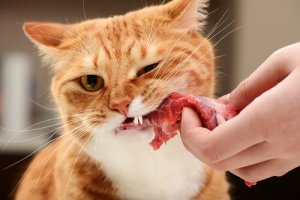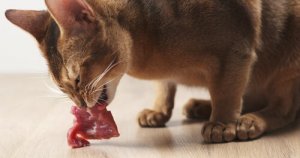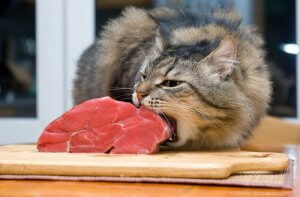Feline Diet and Nutrition: 4 Things You Need to Know


Written and verified by biochemistry Luz Eduviges Thomas-Romero
Getting the right diet and nutrition for your cat can be a real challenge. Anyone who owns a cat will know that the best way to develop a good relationship with them is to understand their needs. In this article, we’ll explain some of the most important things you need to know about feeding your feline friend.
The origins of the feline diet
The domestic cat’s wild ancestors were obligate carnivores, and hunted a wide variety of prey. Eating a diet entirely made up of animal tissue eventually lead to the loss and alteration of their digestive enzymes.
Evolutionary experts believe that these changes represented a distinct advantage, allowing cats to save energy.
Feline diet and nutrition: how do we know what cats should eat?
Outside of academic circles, there is very little information on the exact dietary requirements of the domestic cat.
In recent years, there have been a number of studies into the eating habits of wild cats. These studies have helped to improve knowledge of what cats naturally choose to eat in the wild.
A cat’s daily energy intake is made up of approximately 52% protein, 46% fat, and less than 2% nitrogen-free extract (NFE). This NFE contains carbohydrates such as sugars and starch.
1. Why do cats need so much protein in their diet?
Analyses of the stomach contents of wild cats have shown that their diet is made up of 78% mammals (mainly rodents and rabbits), 16% birds, 3.7% reptiles and amphibians, and 1.2% invertebrates.

Cats are obligate carnivores, which means that they need meat to survive. They require large amounts of taurine, arginine, arachidonic acid, fatty acids, and vitamins in their diet – all of which are only found in sufficient quantities in meat.
The high protein requirement in the feline diet is mainly due to the animal’s inability to “switch off” the enzymes which take part in the digestion of proteins.
Other carnivorous animals, including fish and birds, have also developed this same mechanism when it comes to metabolizing proteins. This suggests that it gives carnivores a significant advantage.
2. Why do cats need taurine in their diet?
While many animals can synthesize taurine from other amino acids, cats are unable to produce sufficient levels in their bodies. This is because they lack the required enzyme to make it themselves.
As a result, taurine is considered an essential part of the feline diet. Both cats and dogs use taurine for the production of bile in the intestinal tract. As such, it is essential for the absorption of fats and fat-soluble vitamins.

Taurine is also important for neurological development, and for regulating the levels of water and salt in the blood. If a cat doesn’t get enough taurine in its diet, it can lead to the degeneration of the photo-receptors – the cellular components in the retinas which detect and react to light.
Finally, taurine deficiency is also closely associated with poor reproductive health, often leading to developmental or cardiac issues in kittens, including conditions such as fetal cardiomyopathy.
It’s important to highlight that taurine isn’t found in food such as vegetables. Meat is by far the best source of taurine for cats, as it is the second most common amino acid in muscle tissue and blood.
3. Feline diet and nutrition: why don’t cats need to eat carbohydrates?
In other animals, carbohydrates such as starch and glucose are metabolized by the enzyme amylase. However, cats have been shown to lack the ability to metabolize carbohydrates properly. The amylase present in their saliva is shown to be fairly inactive, while the amylase in the pancreas and intestines is barely active at all.
They also possess very low levels of many of the other enzymes necessary for metabolizing simple sugars. In fact, cats are unable to taste sugar at all, as they lack the Tas1R2 receptor.
While the animal tissue that makes up the carnivorous diet does contain small quantities of glucose, glucogen, glicoproteins, glucolipids and pentose, it doesn’t contain any starch.
However, when a cat consumes its prey whole, the animal’s entrails sometimes contain small traces of starch. These small amounts of starch in their diet may be the reason why felines have maintained a limited ability to digest carbohydrates.
Not only can cats neither taste nor metabolize large quantities of carbohydrates, but they are also unable to absorb them through their small intestines.
4. Advantages of eating prey whole
Eating prey whole increases their intake of many useful substances, including things such as cartilage, collagen, and glycosaminoglycans.

Digesting these components can actually help to improve gut health. It stimulates the growth of a different subset of good bacteria, which helps to balance gut flora. As a result, getting the right diet and nutrition for your cat can help to optimize the gut’s immune system.
In conclusion, while experts don’t yet fully understand exactly how cats metabolize carbohydrates, the evidence suggests that their ability to digest carbohydrates is limited. To get the right nutrition for your cat, their diet should contain roughly 52% protein (preferably raw), 46% fat, and just 2% carbohydrate.
All cited sources were thoroughly reviewed by our team to ensure their quality, reliability, currency, and validity. The bibliography of this article was considered reliable and of academic or scientific accuracy.
- Rollins, A. W., & Murphy, M. (2019). Nutritional assessment in the cat: Practical recommendations for better medical care. Journal of feline medicine and surgery, 21(5), 442-448.
- Plantinga, E. A., Bosch, G., & Hendriks, W. H. (2011). Estimation of the dietary nutrient profile of free-roaming feral cats: possible implications for nutrition of domestic cats. British Journal of Nutrition, 106(S1), S35-S48. https://core.ac.uk/download/pdf/29232468.pdf
- Hewson-Hughes, A. K., Hewson-Hughes, V. L., Miller, A. T., Hall, S. R., Simpson, S. J., & Raubenheimer, D. (2011). Geometric analysis of macronutrient selection in the adult domestic cat, Felis catus. Journal of Experimental Biology, 214(6), 1039-1051.
This text is provided for informational purposes only and does not replace consultation with a professional. If in doubt, consult your specialist.